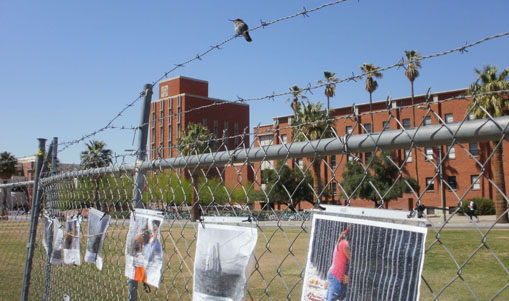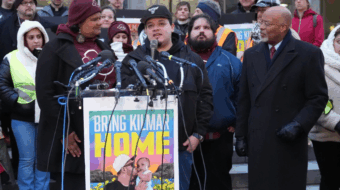
TUCSON – In what is considered the longest mock border wall in the United States, the faculty, staff and students at the University of Arizona are now finding how inconvenient and inhumane it is to have a wall separating human beings from one another.
The structure, entitled “Wall to Wall — Concrete Connections/Conexiones Concretas,” was constructed to bring attention to the situations along the U.S./Mexico border and in Palestine and Israel.
The “wall” is about 1,000 feet long, stands six-feet tall and has barbed-wire at the top, similar to most barriers that have been used to separate countries and people. The “wall” has divided the campus in two in one of its most traveled sections.
One campus organization participated by hanging 8 by 10 photos of families divided by the walls. One photo shows a lady gently touching her young niece through a border fence, while another has a Mexican wife who has driven three hours just to visit her husband through the fence after being deported.
Other organizations hung banners calling for an end to borders and their militarization. One organization hung a Palestinian flag stating how 3.8 million Palestinians are under illegal Israeli military occupation with a 400-mile wall and 120 checkpoints.
The Chicano/Hispano Student Affairs organization hung photos along with biographies of those Latinos who have contributed to American society such as Cesar Chavez and Congressman Raul Grijalva who themselves are the children of immigrants.
The Sierra Club and Defenders of Wildlife contributed by showing how walls along borders harm the environment and endanger wildlife.
The “checkpoints” were openings along the “wall” where faculty, staff and students would have to pass through. Many understood its purpose but a few students were questioned it the inconvenience of having to go through the “checkpoints”.
The point here is not the inconvenience but rather starting an open dialogue with those in favor of borders, separating familes and walls; and showing them that human beings should not be divided simply because of nationality, political persuasion, religious belief or even because of a line on the sand.
The “wall” sends a powerful message and hopefully a few eyes were opened in the process. Perhaps some will now see the wall just 60 miles from campus has a face, name and a loved one who are sitting somewhere thinking and praying to be together again.
Photo: Alexander Monarrez Maldonado










